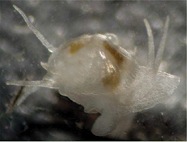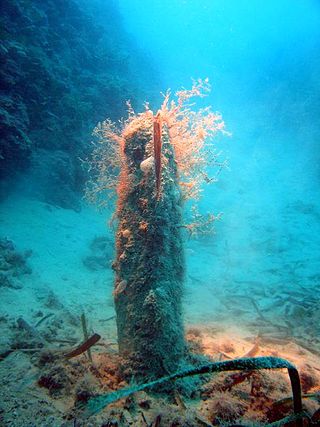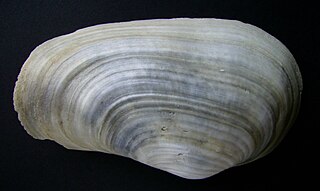
Scallop is a common name that encompasses various species of marine bivalve mollusks in the taxonomic family Pectinidae, the scallops. However, the common name "scallop" is also sometimes applied to species in other closely related families within the superfamily Pectinoidea, which also includes the thorny oysters.

Amalda is a genus of medium-sized sea snails, a marine gastropod mollusc in the family Ancillariidae, the olives and allies.

Amalda australis, common name the southern olive, is a medium-sized sea snail, a gastropod mollusc of the family Ancillariidae. These predatory snails live in the inter-tidal sand, an environment that lends itself to high probability of fossilization. Amalda australis fossils date back to the Pliocene and reveal morphological stasis.

Amalda mucronata is a species of medium-sized sea snail, a marine gastropod mollusc in the family Ancillariidae. These snails live in the sandy subtidal near-shore environment where they eat bivalves. Fossil material of this species provides evidence of morphological stasis over 5 million years

Carditidae is a family of marine bivalve clams of the order Carditida, which was long included in the Venerida. They are the type taxon of the superfamily Carditoidea.

Galeommatidae is a family of small and very small saltwater clams, marine bivalve molluscs in the order Galeommatida.

Lucinidae, common name hatchet shells, is a family of saltwater clams, marine bivalve molluscs.

Thyasiridae is a family of bivalve molluscs, including the cleft clams, in the order Lucinida.

Pinna is a genus of bivalve molluscs belonging to the family Pinnidae.

Panopea is a genus of large marine bivalve molluscs or clams in the family Hiatellidae. There are 10 described species in Panopea. Many of them are known under the common name "geoduck".

Diodora is a genus of small to medium-sized keyhole limpet in the family Fissurellidae.

Ficus is a genus of large sea snails, marine gastropod mollusks in the family Ficidae, the fig shells.

Voluta is a genus of medium to large sea snails, marine gastropod molluscs in the family Volutidae, the volutes.

Clinocerinae is a subfamily of flies belonging to the family Empididae.

Pholadomya is a genus of saltwater clams, marine bivalve molluscs in the family Pholadomyidae.
This list 2020 in paleomalacology is a list of new taxa of ammonites and other fossil cephalopods, as well as fossil gastropods, bivalves and other molluscs that are scheduled to be described during the year 2020, as well as other significant discoveries and events related to molluscan paleontology that are scheduled to occur in the year 2020.
Liostrea is a genus of extinct oysters, marine bivalve mollusks in the family Gryphaeidae.

Glycymeris longior is a species of living marine clam of the genus Glycymeris. It was common in the Quaternary on the Atlantic coast of South America. The shells of this species is frequently found on beaches from Patagonia to Brazil.















